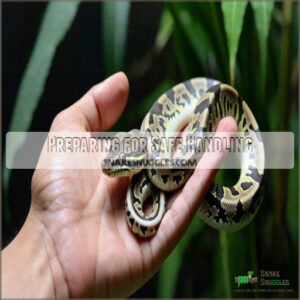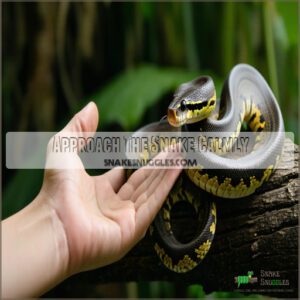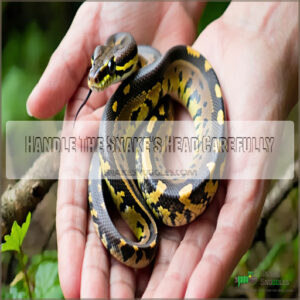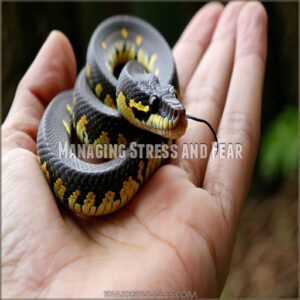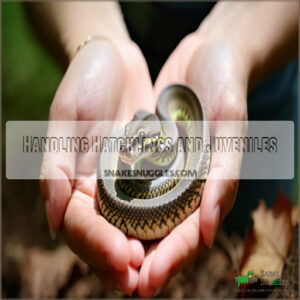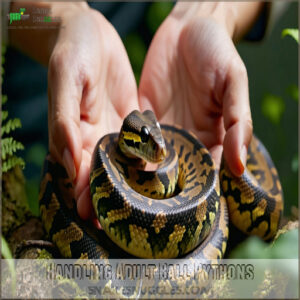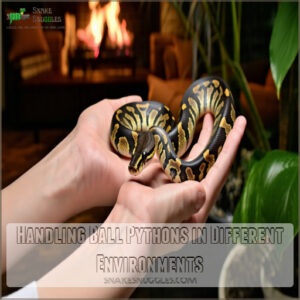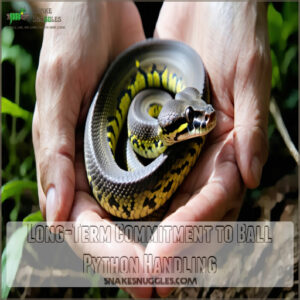This site is supported by our readers. We may earn a commission, at no cost to you, if you purchase through links.
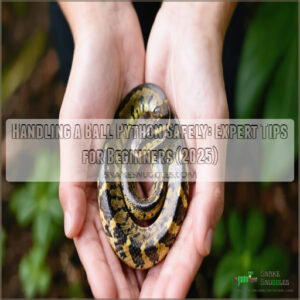 Handling a ball python safely starts with clean hands—yours, not the snake’s! Wash thoroughly to prevent bacteria transfer.
Handling a ball python safely starts with clean hands—yours, not the snake’s! Wash thoroughly to prevent bacteria transfer.
When approaching your snake, think “slow and steady.” Sudden moves can startle it, and no one likes a stressed-out serpent.
Support its entire body as you lift, spreading out your hands like a living hammock. Never grab its head; it’s not a joystick!
Avoid handling after meals or during shedding—imagine someone grabbing you mid-bath or post-feast. Stick to short handling sessions, around 10-15 minutes, to keep things calm.
Want smoother interactions? Consistency and patience go a long way in building trust.
Table Of Contents
- Key Takeaways
- Preparing for Safe Handling
- Choosing The Right Time
- Safe Handling Techniques
- Managing Stress and Fear
- Safety Precautions
- Handling Ball Pythons of Different Ages
- Health Considerations
- Handling Ball Pythons in Different Environments
- Long-Term Commitment to Ball Python Handling
- Common Mistakes to Avoid
- Frequently Asked Questions (FAQs)
- Is it safe to touch a ball python?
- How to handle your ball python for the first time?
- Do ball pythons like being handled?
- Do you have to wash your hands after handling a ball python?
- Do ball pythons like to be handled?
- What not to do with a ball python?
- How do you handle a python safely?
- How do I introduce a ball python to new environments?
- What should I do if my ball python escapes?
- How can I tell if my ball python is sick?
- Conclusion
Key Takeaways
- Wash your hands before and after handling the python to prevent bacteria transfer and avoid confusing the snake with food scents.
- Handle the snake 1–2 times a week, avoid sudden movements, and always support its entire body for a stress-free experience.
- Avoid handling during shedding or right after feeding to prevent stress and potential health issues like regurgitation.
- Watch for stress signs like tight coiling or hissing and respect the snake’s cues to ensure a safe and calm interaction.
Preparing for Safe Handling
Before handling your ball python, wash your hands to remove any lingering food scents and bacteria.
Make sure the terrarium is clean, the humidity and temperature are right, and the snake seems calm and alert.
Wash Hands Before and After Handling
Hand hygiene is key to snake safety.
Washing your hands before and after handling maintains bacteria control and germ prevention. It’s not just polite—it’s essential for clean handling and python safety.
Make it a habit:
- Before handling: Wash to avoid transferring scents or bacteria.
- After handling: Prevent exposure to germs.
- Use soap: Lather thoroughly for best results.
Maintain a Clean Terrarium
A clean terrarium isn’t just nice to look at—it’s key to your ball python’s health! Proper enclosure maintenance prevents illness and keeps your pet happy.
Follow these steps:
- Regularly spot-clean waste to avoid harmful bacteria buildup.
- Do a deep clean monthly using reptile-safe disinfectants. Consider using effective reptile terrarium disinfectants for optimal cleaning.
- Pick a substrate that’s easy to clean yet supports humidity control.
- Remove uneaten food promptly to maintain proper cleanliness.
Healthy terrarium, happy snake—simple as that!
Check Enclosure Temperature and Humidity
Keeping the right temperature and humidity levels in your ball python’s terrarium is paramount for its well-being.
Aim for a balanced temperature control—use heat mats or lamps and check often with a reliable reptile thermometer.
Humidity should stay between 50–60%; regulate it with proper ventilation management and a hygrometer.
For more detailed guidance, review optimal humidity levels for your snake’s health.
A well-maintained heating system prevents stress and illnesses.
Think of the terrarium as your snake’s five-star resort—cozy and perfect!
Skip upkeep, and you might face issues like a reptile tank infested with bugs.
Observe Snake’s Behavior
Pay attention to your ball python’s behavior—it’s their way of speaking.
Relaxed snakes explore and flick tongues, showing calm. Stress signs like tight coiling, fast movements, or sudden hiding signal discomfort.
Recognize these behavioral cues to keep handling positive. Reading snake body language strengthens trust and avoids surprises, like defensive strikes.
It’s all about understanding their reptile communication and instincts!
Choosing The Right Time
Picking the right time to handle your ball python is key to keeping it calm and healthy.
Avoid handling right after meals or during shedding, as these times can cause stress or discomfort for your snake.
Avoid Handling After Meals
After feeding, your ball python needs quiet time to digest—no exceptions! Post-meal handling can upset their digestive health, causing regurgitation and unnecessary stress.
Give them at least 48 hours of undisturbed digestion time. Their feeding schedule typically follows a meal frequency of 1-2 weeks. Understanding snake digestion processes is essential for their overall health.
- Post Meal Care: Observe their behavior; they’ll seek warmth to aid digestion.
- Python Metabolism: Make certain no handling during digestion.
- Avoid Stress: Let them relax entirely.
Avoid Handling During Shedding
During the shedding process, your ball python needs space and minimal handling to avoid stress and health risks.
Handling during shedding can cause irritation, like wearing itchy socks.
Instead, focus on humidity control and observing snake behavior to support smooth skin care.
Wait until the shedding cycle completes for safe, postshedding care—and a happier, healthier snake with good skin care.
Handle Ball Pythons 1-2 Times a Week
Handling ball pythons 1-2 times a week keeps them comfortable and stress-free.
This handling frequency allows your snake to adjust to you without feeling overwhelmed, promoting trust and a calm temperament.
Be patient and use gentle handling techniques suited to the snake’s mood and activity level.
Avoid handling right after meals or during the shedding cycle.
Instead, focus on calm, active moments for safe handling practices.
Always use a calm approach and proper snake restraint.
- Stick to short handling sessions (10–15 minutes).
- Watch for signs of stress, like balling up.
- Always use a gentle touch.
- Let the snake move freely.
Safe Handling Techniques
Handling your ball python safely means approaching it calmly and supporting its entire body to keep both of you comfortable.
Avoid sudden movements, and remember that patience and gentle handling go a long way in building trust.
Approach The Snake Calmly
Approaching your ball python calmly helps build trust.
Think slow movements, a gentle touch, and a calm environment.
Rushing in like it’s a high-speed chase? That startles them!
Confidence shows through steady, deliberate actions.
Read their cues—are they curious or tense?
Treat it like making a new introverted friend: patience and awareness go a long way.
| Calm Approach | Stress Signs | Snake Awareness |
|---|---|---|
| Move slowly | Curling into a ball | Watch tongue flicks |
| Speak softly | Tight coiling | Smooth movements okay |
| Avoid head-first | Head hiding | Avoid startling them |
| Act confidently | Hissing/striking | Build trust gradually |
Support The Snake’s Entire Body
Think of safe snake handling like carrying a fragile vase—you need balance and care.
When handling your ball python, focus on Body Support to keep them secure and at ease:
- Use both hands to support their body evenly.
- Avoid squeezing or gripping too tightly; they’re not a stress ball.
- Notice Snake Posture—any rigid movements signal unease.
Proper python support hooks are essential for maintaining a safe and healthy environment.
Handle The Snake’s Head Carefully
When holding your ball python, patience is key.
Use Head Support by gently cradling the snake’s head without squeezing—think of it like holding a delicate ornament.
A Gentle Touch minimizes stress and helps with Snake Calming, making handling pet snakes smoother.
Avoid pressure on sensitive areas to prioritize Head Safety.
These safe snake handling techniques aren’t just python bite prevention—they build trust.
Ball pythons feel safer when you respect their space, encouraging them to explore freely!
Avoid Sudden Movements
Sudden moves can rattle even the calmest ball python.
Stick to a Calm Approach with Slow Handling in a Quiet Environment.
Use Smooth Movements to reassure your snake, like guiding a kite in a gentle breeze.
These gentle handling techniques help avoid stress and potential bites.
Stay present, read their cues, and your snake will feel safe in your hands.
Managing Stress and Fear
When handling a ball python, it’s important to recognize when your snake feels stressed or scared.
By staying calm, using slow movements, and paying attention to its body language, you’ll help it feel safe and build trust over time, which is crucial for creating a strong bond between you and your snake.
Recognize Stress Signs in Ball Pythons
Spotting stress signals in ball pythons is essential to understanding their needs.
Pay attention to their body language and snake behavior. Watch for:
- Hiding excessively, curling tightly, or unusual movements.
- Tongue flicking nervously, instead of smooth exploration.
- Skipping meals, a common fear response.
Reading snake cues helps you identify ball python stress early and avoid bigger issues like bites or illness.
Minimize Stress During Handling
Ball pythons can be masters of subtle cues, so reducing handling stress starts with observing their behavior.
Use a calm approach, a gentle touch, and avoid sudden movements.
Support their entire body and let them explore without restraint.
By understanding snake handling basics, you can better recognize signs of stress and discomfort.
Here’s a quick guide to stress signs:
| Stress Sign | What It Looks Like | How to Respond |
|---|---|---|
| Hiding | Retreats to a hide | Limit handling, offer space |
| Stiff posture | Tense body, flattened head | Handle gently, avoid handling |
| Rapid tongue flicking | Fast tongue movement | Check for threats/discomfort |
| Hissing | Open mouth, loud exhale | Back away, slow interaction |
| Excessive defecation | Frequent elimination | Review enclosure conditions |
Safe handling techniques improve snake comfort while minimizing stress and fear.
Gentle, consistent handling builds trust!
Build Trust With Your Ball Python
Earning your ball python’s trust takes patience and consistency.
Think of it as snake-scale diplomacy. Use a gentle approach during handling sessions.
Always support their body while avoiding their head—they’re shy that way. Stick to calm handling techniques in a stress-free environment.
Over time, your snake’s temperament will shift—what once felt like uncertainty becomes reassurance. With trust-building and steady handling techniques, you’ll soon have a confident snake ready to explore freely.
Use Positive Reinforcement
Positive reinforcement can make ball python handling more rewarding—for both of you!
Reward training works like charm: offer tasty treats, like small mice, to encourage trust building. Clicker methods add consistency, signaling good behavior with a sound.
Pair this with a calm approach and gentle touch to reinforce positive interactions. Handle your snake patiently, and let it associate handling with safety.
Remember, safe handling techniques and rewards build trust—it’s like earning a snake’s “high five”! Reward training is key to developing a strong bond between you and your ball python.
Safety Precautions
Handling a ball python safely isn’t complicated, but it does take some planning.
By following a few simple precautions, like washing your hands and supervising kids, you’ll keep both you and your snake out of trouble.
Prevent Bites and Injuries
Handling risks start with avoiding snake bites by keeping movements slow and steady—ball pythons dislike surprises.
Snake safety includes washing hands to remove food scents and supporting the snake securely.
Defensive behavior, like hissing or coiling, means it’s uneasy—give it space.
If bitten, stay calm, rinse gently with soap and water, and enjoy a memorable story!
Supervise Children Closely
Kids and snakes require close, calm oversight.
Always keep your eyes on their interaction—children supervision maintains safety for everyone involved.
Teach gentle interaction and use kid-friendly handling tips, like supporting the snake’s body.
Parental guidance helps your child respect the snake’s needs, avoiding snake bites.
Treat it as youth education for safe handling rather than playtime, ensuring safe handling is the priority.
Wash Hands Thoroughly
Wash your hands like you’re prepping for surgery—warm water, plenty of soap, and at least 20 seconds of scrubbing.
Hand hygiene isn’t just about you; it’s germ prevention for your python too.
Clean handling keeps bacteria and Salmonella from sneaking in. Python safety tips start here—your hands are the frontline for safe handling and reptile handling safety.
Seek Medical Attention if Bitten
Getting bitten by your ball python isn’t common, but it’s possible. Stay calm—bites are rarely harmful!
Here’s what to do:
- Assess the injury: Is the bite superficial, or does it require stitches?
- Clean thoroughly: Wash the bite wound with soap and water to prevent infection.
- Seek professional care: Monitor for snake bite symptoms like swelling or redness. A doctor may recommend snake bite treatment, including antibiotics, to prevent a medical emergency from arising.
Handling Ball Pythons of Different Ages
Handling Ball pythons at different ages requires knowing their unique needs and comfort levels. Younger snakes may need gentler, shorter sessions, while adults can handle longer interactions with proper support.
Handling Hatchlings and Juveniles
Baby ball pythons, or "wiggly spaghetti," are naturally shy at first, but with proper care, they’ll warm up.
Use slow, gentle movements during handling, and always support their entire body. Hatchling care focuses on consistent, short interactions to build trust.
It’s important to review handling ball pythons to guarantee a safe experience.
Here’s a quick guide:
| Stage | Handling Frequency | Temperament | Housing Size | Feeding Needs |
|---|---|---|---|---|
| Hatchlings | 2-3 times weekly | Shy | Small | Every 5-7 days |
| Juveniles | 1-2 times weekly | Curious | Medium | Every 7-10 days |
Keep each touch positive!
Handling Adult Ball Pythons
Adult ball pythons require patience and care. Proper ball python husbandry is important for their well-being.
To build trust, follow these steps:
- Handle them 1-2 times weekly, keeping sessions under 30 minutes.
- Provide gentle support for their body, avoiding sudden movements.
- Watch for signs of comfort, like slow exploration.
- If they tense up, stop handling and let them relax.
Respect their temperament for safe handling.
Handling Ball Pythons During Shedding
When your ball python’s shedding process begins, it’s their time for self-care, not extra handling.
Shedding signs like dull skin and blue eyes signal you to focus on humidity control and providing a humid hide for easier skin care.
Skip handling to avoid stress and irritation.
Post shed care involves checking for stuck skin and ensuring they’re comfortable in their enclosure, which is part of their overall skin care.
Health Considerations
If you want your ball python to stay healthy, you’ve got to pay attention to their behavior and environment.
Watch for signs of illness like unusual hiding, weight loss, or breathing issues.
Make sure their enclosure stays clean and comfortable.
Monitoring Ball Python Health
Caring for your ball python means staying on top of its health checks.
Healthy snakes thrive with proper nutrition, clean habitats, and routine monitoring. Watch for the following:
- Weight: Regular weight gain reflects balanced snake nutrition. Use a scale to monitor changes weekly.
- Shedding: Smooth, complete ball python shedding signals healthy skin. Retained skin or cloudy eyes can hint at issues.
- Behavior: Active, curious snakes that eat consistently are typically healthy. Hesitation with food might mean stress or illness.
- Appearance: Check for bumps, parasites, or dull scales. Bright, smooth scales reflect great pet snake health.
Catch problems early to keep your python smiling—figuratively, of course!
Recognizing Signs of Illness and Disease
Keep an eye out for common disease symptoms in your ball python.
Refusal to eat outside shedding cycles, wheezing sounds like a creaky door, or mucus around the mouth can signal respiratory infections.
Flaky shedding and bulging eyes often indicate health problems.
Parasites may cause weight loss, so weigh your python regularly.
Prioritize health checks to catch signs early.
If something seems off, consult a vet for medical treatment—early action is critical for maintaining your python’s health.
Providing Proper Care and Housing
Creating the perfect environment is the backbone of great ball python care.
Enclosure design should allow your python to stretch out comfortably and explore. Choose a soft, absorbent substrate to mimic their natural habitat. Keep fresh water available—hydration is key!
Reliable temperature gradients and humidity control are critical; invest in quality lighting systems to regulate both. Remember, ball pythons thrive in well-maintained homes.
Proper ball python enclosures are essential for their health.
- Enclosure Design: Spacious and escape-proof
- Substrate Options: Coconut fiber or aspen
- Humidity Control: 50-60% humidity
- Temperature Gradients: Warm side ~90°F, cool side ~75°F
Handling Ball Pythons in Different Environments
When handling your ball python in different environments, it’s important to adjust your approach based on the setting.
Whether you’re at home or traveling, staying calm and providing support will keep your snake safe and comfortable.
Handling in Captivity
Creating a safe environment for your ball python starts with a well-maintained snake habitat.
Focus on humidity, warmth, and clutter-free captive care. Handle gently 1-2 times weekly—trust takes patience!
Use climbing branches for enrichment and watch for snake behavior cues to avoid stress.
Follow secure snake handling tips: steady hands, light touch, no sudden movements. With consistent ball python handling in captivity, you’ll foster trust and help your snake thrive in its cozy environment!
Handling in Transit
Traveling with your snake? Think “comfort first.” Use secure travel containers or snake bags with soft bedding to keep your ball python snug and safe.
Add a heat pack if it’s chilly outside—your snake will appreciate it. Handling in transit should be minimal; pit stops aren’t their thing.
Always focus on carrier safety by choosing escape-proof options. Safe handling during road trips means avoiding sudden movements and keeping the environment calm.
Treat your python to smooth travels with these transit tips!
Special Considerations for Handling
When handling ball pythons, special situations need extra care:
- Pregnant snakes: Reduce stress to boost breeding success.
- Illness: Minimize handling to avoid worsening their condition.
- Temperament: Some genetic traits affect behavior, so adjust handling techniques.
- Environment: Quiet spaces help lower stress.
These tips improve your ball python handling experience and provide safety for both you and your snake.
Long-Term Commitment to Ball Python Handling
When you handle a ball python, you’re committing to a long-term relationship built on trust and patience.
Regular, gentle interactions keep your snake comfortable, but rushing things can lead to unnecessary stress for both of you, requiring patience.
Building a Relationship With Your Ball Python
Building trust with your ball python takes time and understanding their unique personality.
Gentle handling and consistent interaction are essential bonding techniques.
Regular handling offers numerous benefits for your snake.
Spend quiet moments near the enclosure daily so your snake feels your presence.
Handle weekly, using safe handling techniques like supporting their body and avoiding sudden moves.
Observe python communication, like slow movements or tongue flicks, to gauge comfort.
You can learn more about safe ball python handling.
Building this relationship enhances bonding and encourages positive ball python behavior.
Managing Stress and Fear Long-Term
When managing stress and fear long-term, consistency and trust go hand in hand.
Ball pythons thrive with gentle handling, a calm environment, and steady routines. Watch their body language—if they’re balled up or hiding, they need a break. Patience pays off, especially with shy temperaments.
- Stick to a regular handling frequency.
- Create a calm, quiet environment.
- Learn your python’s temperament for better Fear Management.
- Use calming techniques like slow movements.
Maintaining a Clean Environment
Keeping a spotless terrarium makes sure your ball python stays healthy and stress-free.
Regular terrarium cleaning, including waste removal and disinfecting with reptile-safe products, prevents parasites.
Control temperature and humidity with proper storage for Snake Hygiene. Frequent enclosure maintenance reduces bacteria buildup.
Think of it as crafting their perfect home spa—cleanliness keeps your python happy and flicking its tongue in appreciation, creating a healthy environment that supports their overall well-being, which is essential for a stress-free life.
Common Mistakes to Avoid
It’s easy to make simple mistakes when handling a ball python, but they can leave your snake stressed or even sick.
By avoiding things like over-handling, skipping handwashing, or ignoring your snake’s signals, you’ll keep both of you safe and comfortable.
Handling Too Frequently
Too much handling can leave your ball python feeling frazzled, much like being stuck in an endless meet-and-greet.
It’s all about balance. Watch for stress signs to spot when they’re overwhelmed.
- Stick to 1-3 sessions a week to avoid burnout.
- Limit sessions to 10-15 minutes.
- Skip handling if they’ve recently eaten.
- Let them acclimate after introducing new changes.
Consistency beats overhandling every time.
Not Washing Hands Properly
Hand washing isn’t optional—it’s a must for handling safety.
Dirty environments and poor hand hygiene can lead to bacterial transfer, skin infections, or germ spread.
Besides protecting yourself, clean hands prevent your python from picking up harmful bacteria.
Wash with soap and water before and after handling.
Skip shortcuts like food-scented hand sanitizers; they confuse your python, increasing bite risks.
Think of it as basic safety precautions—you’re keeping yourself healthy and showing respect for your python’s health, which is essential for maintaining a safe and healthy environment, and can be considered an act of respect.
Ignoring Snake’s Body Language
Reading your snake’s body language is as important as clean hands.
Ball pythons communicate discomfort through their behavior—ignoring these signs leads to handling mistakes and unhappy snakes.
A tight coil, hissing, or striking shows stress or fear.
Respect their signals to avoid bites or stress.
Watch for these stress signs:
- Tight coiling means, “I need space!”
- Hissing? They’re scared or warning you.
- Balling up signals discomfort.
- Defensive striking means fear, not aggression.
- Restless movement shows they’re uneasy.
Handle gently and watch for snake comfort cues.
Frequently Asked Questions (FAQs)
Is it safe to touch a ball python?
Touching a ball python is like shaking hands with someone shy—approach gently and respectfully.
They’re safe to handle if you’re calm, avoid sudden movements, and steer clear of their head or post-meal periods.
How to handle your ball python for the first time?
Start by letting your ball python settle in its tank for 1-2 weeks.
When handling, move slowly, approach mid-body, and support its weight.
Avoid touching its head—patience and gentleness build trust over time.
Do ball pythons like being handled?
Think of handling as a slow dance; ball pythons tolerate it more than enjoy it.
They don’t bond like mammals, but regular, gentle handling builds trust, keeping stress low and making interactions smoother for both of you.
Do you have to wash your hands after handling a ball python?
Yes, always wash your hands after handling a ball python.
It prevents spreading bacteria like salmonella and keeps you safe.
Plus, it removes scents that could confuse the snake next time you handle it!
Do ball pythons like to be handled?
Ball pythons don’t “love” handling like a pet dog might wag its tail, but they tolerate it well when they feel safe.
With gentle handling, they become comfortable, exploring calmly without signs of stress.
What not to do with a ball python?
Avoid grabbing its head or tail, handling after feeding, or during shedding.
Don’t skip washing your hands; they might mistake fingers for snacks.
And please, don’t let it wrap tightly around your neck!
How do you handle a python safely?
Grabbing a python carelessly is like poking a bear—it won’t end well.
Slide your hands under its body, support its weight, and move slowly.
Don’t squeeze or touch its head; stay calm, confident, and gentle.
How do I introduce a ball python to new environments?
Introduce your ball python to new environments slowly.
Let it explore at its own pace while ensuring the area is safe and escape-proof.
Stay nearby, offer support, and watch for signs of stress or curiosity.
What should I do if my ball python escapes?
Losing a snake feels like finding a needle in a haystack, but stay calm.
Search warm, dark spots like under furniture. Use flour trails to track movement.
Secure doors, and check at night when it’s active.
How can I tell if my ball python is sick?
Watch for signs like wheezing, unusual lethargy, refusal to eat, or prolonged hiding.
Bubbles around the nose or mouth indicate respiratory issues.
Skin infections, stuck shed, or unusual swelling are also red flags for sickness.
Conclusion
Think of handling a ball python safely like dancing with a cautious partner—move gently, match its rhythm, and build trust over time.
Always wash your hands, support its body fully, and avoid stressful moments like shedding or post-meals.
Patience and consistency help create a calm and rewarding experience for you and your snake.
Respect its cues, keep sessions short, and prioritize its health and comfort.
With care, you’ll develop a confident, stress-free bond.
- https://pangovet.com/pet-health-wellness/snakes/how-to-take-care-of-a-ball-python/
- https://www.proherper.com/knowledge/blog/ball-python-handling
- https://www.terrariumquest.com/ball-python/handling/
- https://reptifiles.com/ball-python-care-guide/ball-python-handling-tips/
- https://pethelpful.com/reptiles-amphibians/Ball-Python-Care-Sheet-How-To-Properly-Care-For-A-Ball-Python

